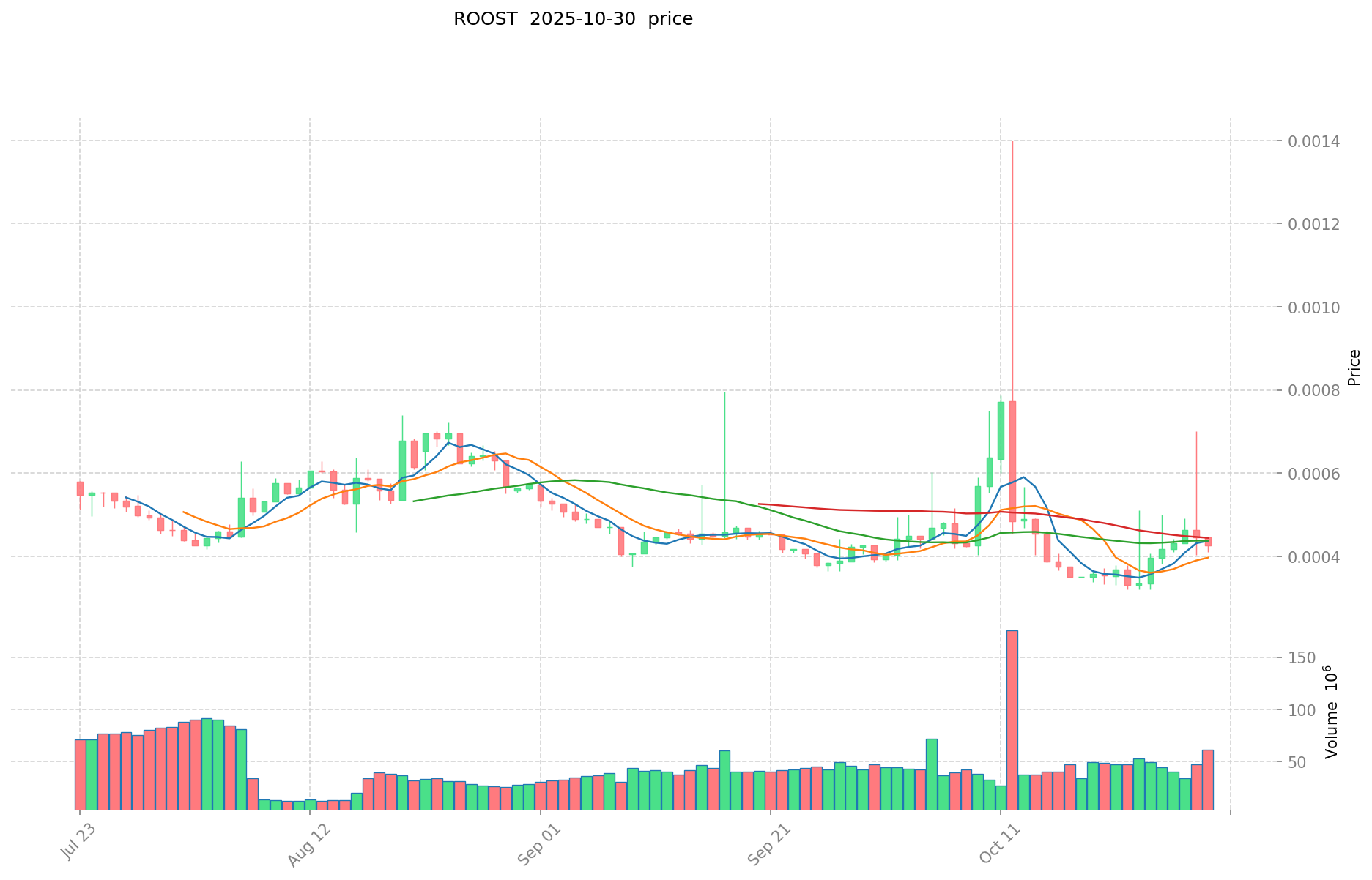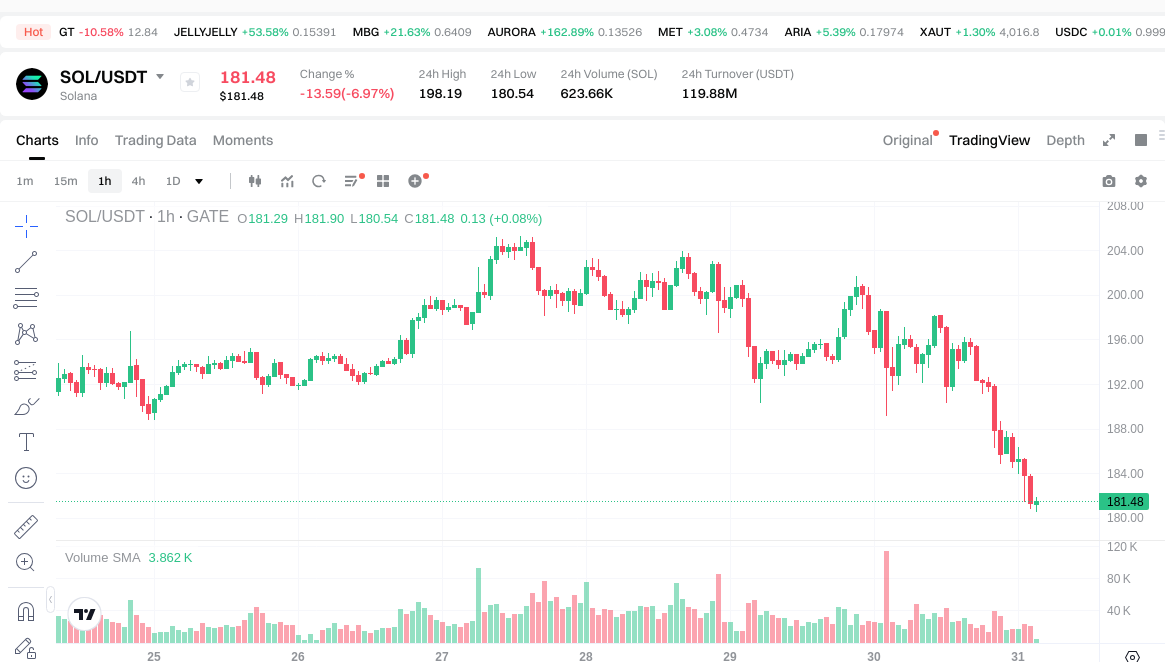ROOST vs SOL: Comparing Two Emerging Blockchain Platforms for DeFi Applications
Introduction: ROOST vs SOL Investment Comparison
In the cryptocurrency market, ROOST vs SOL comparison has always been a topic that investors can't avoid. The two not only have significant differences in market cap ranking, application scenarios, and price performance, but also represent different crypto asset positioning.
ROOST (ROOST): Since its launch, it has gained market recognition as the champion of the Base ecosystem.
SOL (SOL): Since its inception in late 2017, it has been hailed as a high-performance blockchain protocol, and is one of the cryptocurrencies with the highest global trading volume and market capitalization.
This article will comprehensively analyze the investment value comparison between ROOST and SOL, focusing on historical price trends, supply mechanisms, institutional adoption, technological ecosystems, and future predictions, and attempt to answer the question that investors are most concerned about:
"Which is the better buy right now?"
I. Price History Comparison and Current Market Status
ROOST and SOL Historical Price Trends
- 2024: ROOST reached its all-time high of $0.09382, likely due to increased adoption or a major partnership.
- 2025: SOL hit a record high of $293.31, possibly influenced by significant ecosystem growth or technological upgrades.
- Comparative analysis: In the recent market cycle, ROOST dropped from its peak of $0.09382 to a low of $0.00028, while SOL demonstrated more resilience, maintaining a higher price point above $180.
Current Market Situation (2025-10-31)
- ROOST current price: $0.000401
- SOL current price: $181.64
- 24-hour trading volume: ROOST $16,968.49 vs SOL $120,294,889.93
- Market Sentiment Index (Fear & Greed Index): 34 (Fear)
Click to view real-time prices:
- Check ROOST current price Market Price
- Check SOL current price Market Price


II. Core Factors Influencing ROOST vs SOL Investment Value
Market Sentiment
- Market mood and investor confidence directly impact the price trends of both tokens
- Regulatory environment: Government policies and regulations directly influence market acceptance
Western Union's Adoption of Solana
- Western Union plans to launch the USDPT stablecoin on the Solana blockchain by 2026
- The initiative aims to provide faster, cheaper, and more reliable payment methods
- Western Union CEO stated: "Solana is the right choice for us"
Regulatory Environment
- Government policies toward cryptocurrencies significantly affect their market acceptance
- Regulatory clarity or uncertainty can drive or hinder institutional adoption
- Different jurisdictional approaches create varying investment landscapes
Technical Attributes
- Solana offers high-speed transaction processing and lower fees compared to many competing blockchains
- SOL serves as the native token powering the Solana ecosystem
- Limited information available regarding ROOST's technical specifications
III. 2025-2030 Price Prediction: ROOST vs SOL
Short-term Prediction (2025)
- ROOST: Conservative $0.00029674 - $0.000401 | Optimistic $0.000401 - $0.0004812
- SOL: Conservative $159.544 - $181.3 | Optimistic $181.3 - $244.755
Mid-term Prediction (2027)
- ROOST may enter a growth phase, with expected prices ranging from $0.000339360285 to $0.000722984955
- SOL may enter a bullish market, with expected prices ranging from $136.763655 to $296.3212525
- Key drivers: Institutional capital inflow, ETF, ecosystem development
Long-term Prediction (2030)
- ROOST: Base scenario $0.00081730996178 - $0.000907214057576 | Optimistic scenario $0.000907214057576
- SOL: Base scenario $340.585949137875 - $470.0086098102675 | Optimistic scenario $470.0086098102675
Disclaimer: The above predictions are based on historical data and market analysis. Cryptocurrency markets are highly volatile and subject to rapid changes. These forecasts should not be considered as financial advice. Always conduct your own research before making investment decisions.
ROOST:
| 年份 | 预测最高价 | 预测平均价格 | 预测最低价 | 涨跌幅 |
|---|---|---|---|---|
| 2025 | 0.0004812 | 0.000401 | 0.00029674 | 0 |
| 2026 | 0.000542553 | 0.0004411 | 0.000304359 | 10 |
| 2027 | 0.000722984955 | 0.0004918265 | 0.000339360285 | 22 |
| 2028 | 0.000795701503025 | 0.0006074057275 | 0.000479850524725 | 51 |
| 2029 | 0.000933066308299 | 0.000701553615262 | 0.000491087530683 | 74 |
| 2030 | 0.000907214057576 | 0.00081730996178 | 0.000768271364073 | 103 |
SOL:
| 年份 | 预测最高价 | 预测平均价格 | 预测最低价 | 涨跌幅 |
|---|---|---|---|---|
| 2025 | 244.755 | 181.3 | 159.544 | 0 |
| 2026 | 242.85135 | 213.0275 | 123.55595 | 17 |
| 2027 | 296.3212525 | 227.939425 | 136.763655 | 25 |
| 2028 | 296.2072827875 | 262.13033875 | 175.6273269625 | 44 |
| 2029 | 402.003087507 | 279.16881076875 | 245.6685534765 | 53 |
| 2030 | 470.0086098102675 | 340.585949137875 | 269.06289981892125 | 87 |
IV. Investment Strategy Comparison: ROOST vs SOL
Long-term vs Short-term Investment Strategies
- ROOST: Suitable for investors focusing on Base ecosystem potential
- SOL: Suitable for investors seeking high-performance blockchain exposure
Risk Management and Asset Allocation
- Conservative investors: ROOST: 10% vs SOL: 90%
- Aggressive investors: ROOST: 30% vs SOL: 70%
- Hedging tools: Stablecoin allocation, options, cross-currency portfolio
V. Potential Risk Comparison
Market Risk
- ROOST: Higher volatility due to lower market cap and trading volume
- SOL: Exposure to broader crypto market trends and sentiment
Technical Risk
- ROOST: Limited information on scalability and network stability
- SOL: Potential network congestion during high-traffic periods
Regulatory Risk
- Global regulatory policies may impact both tokens differently, with SOL potentially facing more scrutiny due to its larger market presence
VI. Conclusion: Which Is the Better Buy?
📌 Investment Value Summary:
- ROOST advantages: Potential growth as a champion of the Base ecosystem
- SOL advantages: High-performance blockchain, institutional adoption (e.g., Western Union), larger ecosystem
✅ Investment Advice:
- New investors: Consider allocating a larger portion to SOL due to its established market position
- Experienced investors: Explore a balanced portfolio with both ROOST and SOL to capitalize on potential growth in both ecosystems
- Institutional investors: Focus on SOL due to its liquidity, market cap, and growing institutional adoption
⚠️ Risk Warning: The cryptocurrency market is highly volatile, and this article does not constitute investment advice. None
VII. FAQ
Q1: What are the main differences between ROOST and SOL? A: ROOST is the champion token of the Base ecosystem, while SOL is the native token of the Solana blockchain. SOL has a much larger market cap, higher trading volume, and is more widely adopted by institutions. Solana is known for its high-speed transactions and low fees, while less technical information is available about ROOST.
Q2: Which token has shown better price performance recently? A: SOL has demonstrated more resilience in the recent market cycle. While ROOST dropped from its peak of $0.09382 to $0.000401, SOL has maintained a higher price point above $180.
Q3: How does Western Union's adoption affect SOL's investment potential? A: Western Union's plan to launch a stablecoin on the Solana blockchain by 2026 is a significant boost for SOL. This institutional adoption increases SOL's credibility and potential for growth in the payments sector.
Q4: What are the price predictions for ROOST and SOL in 2030? A: For ROOST, the base scenario predicts a range of $0.00081730996178 to $0.000907214057576. For SOL, the base scenario predicts a range of $340.585949137875 to $470.0086098102675. However, these are speculative predictions and should not be considered financial advice.
Q5: How should investors allocate their portfolio between ROOST and SOL? A: Conservative investors might consider allocating 10% to ROOST and 90% to SOL, while more aggressive investors might opt for 30% ROOST and 70% SOL. The exact allocation should depend on individual risk tolerance and investment goals.
Q6: What are the main risks associated with investing in ROOST and SOL? A: Both tokens face market risks related to crypto volatility. ROOST may have higher volatility due to its lower market cap. SOL faces potential technical risks like network congestion. Both tokens are subject to regulatory risks, with SOL potentially facing more scrutiny due to its larger market presence.
Q7: Which token is recommended for new investors? A: New investors might consider allocating a larger portion to SOL due to its established market position, higher liquidity, and growing institutional adoption. However, all investment decisions should be based on personal research and risk assessment.
Share
Content